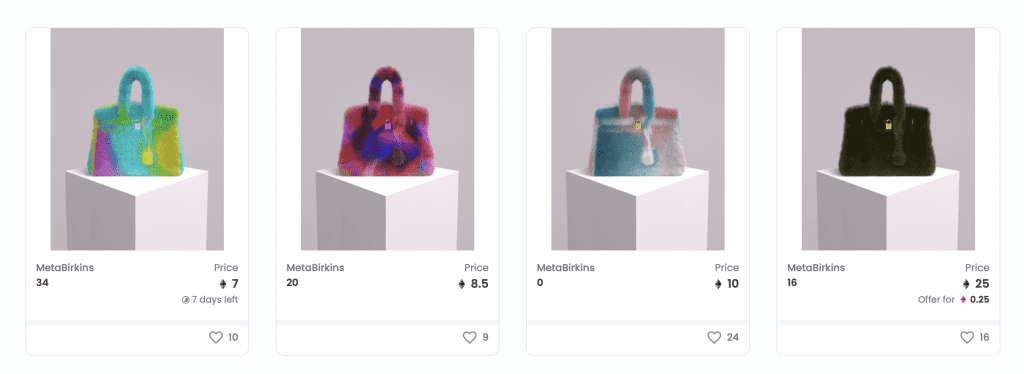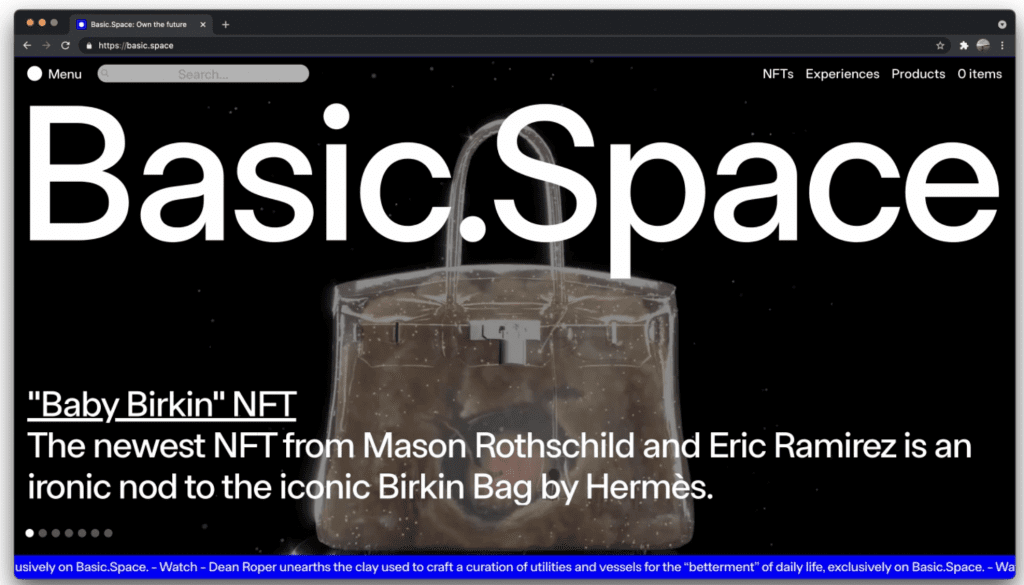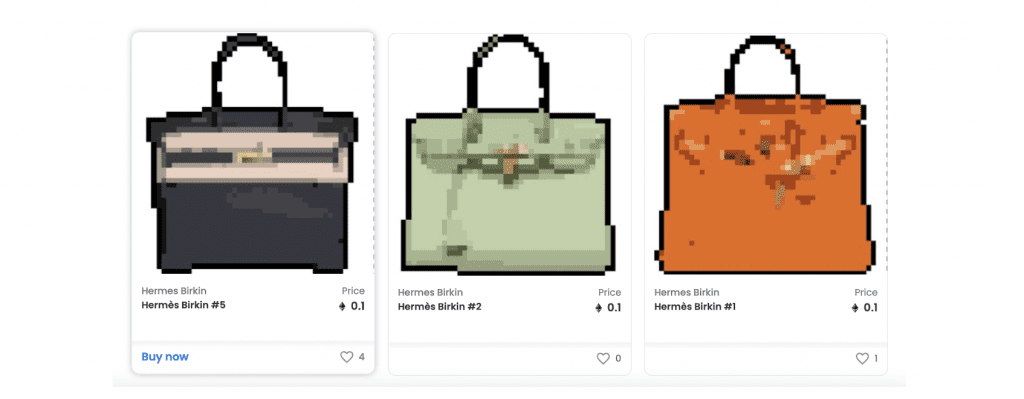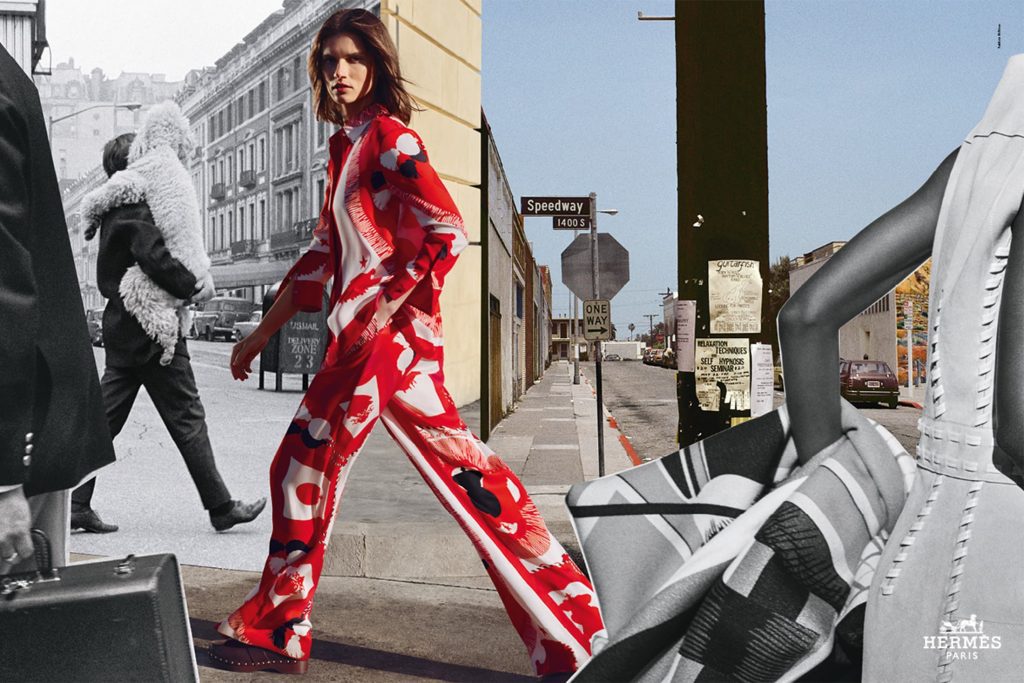Hermès’ Birkin bags are swiftly becoming the posterchild of the increasingly widespread – and unauthorized – use of brands’ valuable assets in the metaverse. The French luxury goods brand spoke out this past week, asserting that it “did not authorize nor consent to the commercialization or creation” of 100 virtual Birkin bag-centric non-fungible tokens (“NFTs”) that artist Mason Rothschild has been offering up. A rep for Hermès told the FT that Rothschild’s “MetaBirkins” NFTs “infringe upon [its] trademark rights, and are an example of fake Hermès products in the metaverse.” Hermès’ statement follows from Mr. Rothschild touting the success of the MetaBirkins, including the sale of the very first one for roughly $40,000 in Ether and total sales of almost $800,000 as of late last week.
Interestingly enough, Hermès is not the only one being copied in this equation. In an interview on December 6, Rothschild shed light on the proliferation of “fake” versions of his allegedly infringing NFTs, telling Yahoo Finance that before he actually made the MetaBirkins available for purchase on OpenSea, “a bunch of counterfeit [MetaBirkins] that were not from my collection” appeared on the NFT marketplace. “We are in the process of verifying mine on OpenSea,” where the MetaBirkins page states that the furry NFTs are “not affiliated, associated, authorized, endorsed by, or in any way officially connected with Hérmes, or any of its subsidiaries or its affiliates,” Rothchild told Yahoo of the multi-colored MetaBirkins. “But we had like $35,000 [or] $40,000 in volume of people buying fake versions. So, yeah, counterfeits are definitely there.”

Distancing itself from the unauthorized NFTs created by Rothschild and the unnamed “counterfeiters,” the normally tight-lipped Hermès stated that it has not yet entered into the burgeoning NFT space even as brands like Gucci, Rimowa, Givenchy, Bulgari, Dolce & Gabbana, and Jimmy Choo, among others, continue to tap into the increasingly mainstream appeal of the crypto market, and the nearly 185-year-old brand does not appear to have any immediate plans to do so, saying that it “values the ‘tangible expression of handcrafted physical objects.’”
From Baby Birkins to MetaBirkins
The MetaBirkins are not Rothschild’s first NFTs to play on the well-established reputation of Hermès’ bags; he he made headlines earlier this year when he released the “Baby Birkin” NFT in collaboration with fellow artist Eric Ramirez. The “Baby Birkin” – which consists of a 2000 x 2000 pixel of a Birkin bag adorned with the design of a 40-week-old fetus, and which has been described by its creators as “an ironic nod to the iconic Birkin Bag by Hermès” – swiftly sold for the equivalent of $23,500 this spring, and more recently resold for $42,000, according to Rothschild.
Given that the Baby Birkin appeared to enter into the market without any public-facing pushback or trademark litigation from Hérmes (maybe due to Hérmes’ counsel’s consideration of potential fair use protections in the U.S. and/or perhaps, the brand’s desire to avoid unwanted press that might serve to draw even more attention to the one-off art project), Rothschild may have been emboldened to create his newer collection of NFTs without fear of legal ramifications. This time around, though, things may be different.

There is a chance that the MetaBirkins may not experience the same fate as the Baby Birkin NFT – if for no other reason than the sheer difference in the number of NFTs up for offer. As distinct from the Baby Birkin, which consisted of a single NFT, the MetaBirkins come in a volume of 100, which can be acquired and then consistently resold as part of the buoyant secondary market for NFTs. This very well may remove Rothschild’s ability to rely on certain fair use factors, namely, the hypothetical argument that he is not making use of Hérmes’ trademarks – including its trademark-protected Birkin name and the source-indicating appearance of the bag, itself – in a commercial capacity.
At the same time, any potential “irony” or commentary that Rothschild and Ramirez may have put forth by way of the Baby Birkin – which they said was a play on the smallest size of the specific Hérmes style and which “has been having a moment in pop culture” – that could possibly allow them to argue fair use on the basis of parody or satire seems to have gone away, as well. Addressing the significance of the MetaBirkins, Rothschild’s OpenSea page describes the NFTs simply “a tribute to Hérmes’ most famous handbag,” which would likely provide far less room for such fair use-centric arguments.
As for the critical trademark infringement element of confusion, Hérmes could likely point to the frequency with which high fashion and luxury goods brands are entering into the metaverse by way of NFTs and gaming complete with virtual goods – and almost exclusively by way of collaborations with third parties – as evidence that consumers may be confused as to the source of the MetaBirkins and/or Hérmes’ affiliation with them in an initial and post-sale capacity. The brand could also also argue that the value of the MetaBirkin NFTs is heavily grounded in the appeal of the Birkin bag, which as Rothschild puts it, is “one of the most exclusive, well-made luxury accessories, [with] its mysterious waitlist, intimidating price tags, and extreme scarcity.” In other words, the MetaBirkins trade on the Hérmes brand and its offerings (without authorization) in order to generate demand and value.

While Hérmes has not revealed whether legal action is in the cards, it is worth noting that Rothschild is not the only party that has benefitted from the appeal of Hermès’ famous offerings in connection with the creation of virtual products, as others have produced similar products in the past and have taken to offering them up via OpenSea and other marketplaces. (For a look at the various legal issues at play for marketplaces amid the rise of NFTs and corresponding infringements, you can find that here.)
And still yet, there are more instances of NFTs that make use of Hérmes’ famed products in the pipeline. Iris World has announced the launch of a collaboration with Kardashian Kloset for “an exclusive NFT drop of a Kim Kardashian Hermès Birkin handbag,” which is slated to be offered up for auction on December 21. According to a release from Iris World, the crypto company “will facilitate a 1 of 1 NFT drop in collaboration with Kardashian Kloset” in connection with which “the winning bidder will not only receive a unique NFT but also a one-of-a-kind Hermès Birkin bag with a signed packaging by reality TV and social media star Kim Kardashian.”
Ultimately, the MetaBirkins and other unauthorized trademark-bearing products, from Louis Vuitton x Supreme hoodies to Chanel jackets, are some of the latest examples of the evolving pool of legal issues that brands face in the metaverse. The enduring demand for NFTs and virtual fashion provides brands with “a great opportunity to build loyalty in their followers and customers,” according to Orrick attorneys Sheryl Koval Garko, Mark Puzella, and Caroline Simons. However, as these instances indicate, “brands should be vigilant about theft of their works and police conduct that could weaken or dilute their marks,” and they would be wise to “review their existing [trademark uses and] registrations in order to determine if the classifications of goods/services currently listed do not provide them with “enough coverage for NFTs” and digital fashion more broadly, and if they do not, they should seek to build new rights whenever possible.
Updated (Dec. 14, 2021): This article was updated to include a reference to a Birkin NFT from Iris World.













